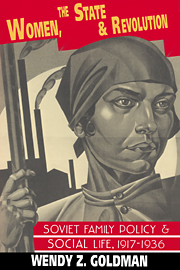Book contents
- Frontmatter
- Contents
- List of tables
- Acknowledgments
- 1 The origins of the Bolshevik vision: Love unfettered, women free
- 2 The first retreat: Besprizornost' and socialized child rearing
- 3 Law and life collide: Free union and the wage-earning population
- 4 Stirring the sea of peasant stagnation
- 5 Pruning the “bourgeois thicket”: Drafting a new Family Code
- 6 Sexual freedom or social chaos: The debate on the 1926 Code
- 7 Controlling reproduction: Women versus the state
- 8 Recasting the vision: The resurrection of the family
- Conclusion: Stalin's oxymorons: Socialist state, law, and family
- Index
- Soviet and East European Studies
7 - Controlling reproduction: Women versus the state
Published online by Cambridge University Press: 26 March 2010
- Frontmatter
- Contents
- List of tables
- Acknowledgments
- 1 The origins of the Bolshevik vision: Love unfettered, women free
- 2 The first retreat: Besprizornost' and socialized child rearing
- 3 Law and life collide: Free union and the wage-earning population
- 4 Stirring the sea of peasant stagnation
- 5 Pruning the “bourgeois thicket”: Drafting a new Family Code
- 6 Sexual freedom or social chaos: The debate on the 1926 Code
- 7 Controlling reproduction: Women versus the state
- 8 Recasting the vision: The resurrection of the family
- Conclusion: Stalin's oxymorons: Socialist state, law, and family
- Index
- Soviet and East European Studies
Summary
The primary means of regulating the birthrate within the family was artificially induced miscarriage or abortion.
Soviet demographers A. G. Vishnevskii and A. G. Volkhov commenting on the 1920s and early 1930sIn the spring of 1920, when abortion was still prohibited in the Soviet Union, Nikolai Semashko, the commissar of health, was deluged by letters concerning the frightening popularity of the practice. One worker from a factory staffed largely by young women wrote, “Within the past six months, among 100 to 150 young people under age 25, I have seen 15 to 20 percent of them making abortions without a doctor's help. They simply use household products: They drink bleach and other poisonous mixtures.” The letters, from Party members as well as workers, indicated that the law against abortion did little to deter women who wanted to terminate their pregnancies.
The practice of abortion had been widespread in Russia prior to the Revolution despite the strict legal prohibition against it. The Criminal Code of 1885 defined abortion as a “premeditated act” of murder. It prescribed stiff punishment for both those who performed and those who underwent the procedure. After 1905, many doctors and jurists urged reform of the abortion laws; prominent professional organizations recommended legalization. Yet despite criticism of the existing legislation, only a few advanced the feminist argument that women had the right to make their own reproductive choices.
The October Revolution and subsequent civil war did little to halt the practice of underground abortion. In fact, famine, hardship, and economic ruin spurred increasing numbers of women to seek illegal abortions.
- Type
- Chapter
- Information
- Women, the State and RevolutionSoviet Family Policy and Social Life, 1917–1936, pp. 254 - 295Publisher: Cambridge University PressPrint publication year: 1993
- 1
- Cited by



